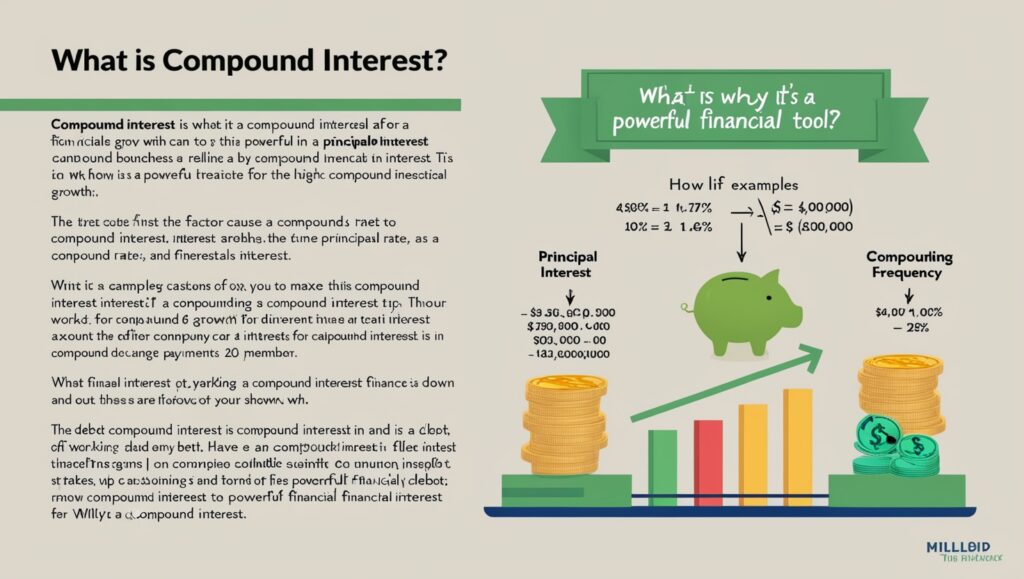What You Need to Know About Compound Interest
Compound interest is often called the “eighth wonder of the world,” and for good reason. This powerful financial concept has the ability to grow wealth exponentially over time, making it a cornerstone of investing and saving strategies. Whether you’re planning for retirement, saving for your child’s education, or building a nest egg, understanding compound interest can transform your financial future. Here’s an in-depth look at what compound interest is, how it works, and why it’s so impactful.
What Is Compound Interest?
Compound interest is the process of earning interest on both the initial principal amount and the accumulated interest from previous periods. Unlike simple interest, which is calculated only on the principal, compound interest allows your money to grow at a faster rate over time.
Formula for Compound Interest
The formula for compound interest is:
A=P×(1+r/n)n×t
Where:
- A = Future value of the investment/loan, including interest
- P = Principal amount (initial investment or loan)
- r = Annual interest rate (decimal form)
- n = Number of times interest is compounded per year
- t = Time the money is invested or borrowed for (in years)
How Does Compound Interest Work?
The key to compound interest is time and frequency of compounding. Here’s how it operates:
- Principal Growth: Your initial investment (principal) earns interest.
- Interest on Interest: As interest is added to your principal, the total grows, and future interest calculations include the added interest.
- Compounding Frequency: The more frequently interest compounds (e.g., annually, semi-annually, quarterly, monthly, or daily), the faster your money grows.
Why Is Compound Interest Powerful?
The key to compound interest is time and frequency of compounding. Here’s how it operates:
- Principal Growth: Your initial investment (principal) earns interest.
- Interest on Interest: As interest is added to your principal, the total grows, and future interest calculations include the added interest.
- Compounding Frequency: The more frequently interest compounds (e.g., annually, semi-annually, quarterly, monthly, or daily), the faster your money grows.
Why Is Compound Interest Powerful?
- Exponential Growth: Unlike linear growth in simple interest, compound interest grows exponentially. Over time, this can lead to significantly larger returns.
- “The Snowball Effect”: The longer your money is invested, the more pronounced the effect of compounding. Even small investments can grow substantially over decades.
- Time Advantage: Starting early gives your money more time to compound, which can make a massive difference in the long run.
Real-Life Examples of Compound Interest
1. Investing in a Savings Account
Let’s say you invest $1,000 in a savings account with a 5% annual interest rate, compounded yearly:
- Year 1: $1,000 × (1 + 0.05) = $1,050
- Year 2: $1,050 × (1 + 0.05) = $1,102.50
- Year 3: $1,102.50 × (1 + 0.05) = $1,157.63
In just three years, your initial $1,000 grows to $1,157.63 without any additional contributions.
2. Long-Term Investment
Consider a 25-year-old who invests $5,000 annually in a retirement account earning 7% interest, compounded yearly. By age 65, they would have over $1 million, even though they only contributed $200,000 out of pocket.
Factors That Affect Compound Interest
1. Principal Amount
The more money you invest initially, the greater the base for compounding.
2. Interest Rate
Higher interest rates lead to faster growth, but they may come with higher risk in investments.
3. Compounding Frequency
Frequent compounding increases the total amount of interest earned. For example:
- Annual compounding grows slower than monthly or daily compounding.
4. Time
Time is the most critical factor. The earlier you start, the more dramatic the impact of compounding becomes.
The Rule of 72: A Quick Shortcut
The Rule of 72 is a simple way to estimate how long it will take for an investment to double, given a fixed annual rate of return.
Time to Double (in years)=Annual Interest Rate (%)72
For example, at an 8% annual interest rate:
72÷8=9 years to double your investment.
Applications of Compound Interest
- Savings Accounts: Grow your money safely over time.
- Retirement Accounts (e.g., 401(k), IRA): Leverage compounding for long-term wealth.
- Loans: Be mindful of compound interest in debt, as it can increase what you owe.
- Investments: Stocks, bonds, and mutual funds often rely on compounding returns for growth.
Tips to Maximize Compound Interest
- Start Early: Even small contributions made early will compound into significant sums.
- Invest Regularly: Consistent contributions build your principal over time.
- Choose High-Interest Accounts: Look for competitive interest rates while managing risk.
- Avoid Withdrawals: Let your money grow uninterrupted to maximize compounding.
- Reinvest Earnings: Ensure dividends and earnings are reinvested to benefit from compounding.
The Flip Side: Compound Interest in Debt
While compound interest is excellent for savings and investments, it can be a nightmare when applied to debt. Credit cards, for example, often compound interest daily, causing balances to grow rapidly if not paid off. Always aim to minimize debt to avoid the adverse effects of compounding.
Final Thoughts
Compound interest is a fundamental concept that can work wonders for your financial well-being. By starting early, investing wisely, and allowing time to work its magic, you can build substantial wealth with relatively little effort. Whether you’re saving, investing, or managing debt, understanding and leveraging compound interest is a game-changer for achieving your financial goals.

